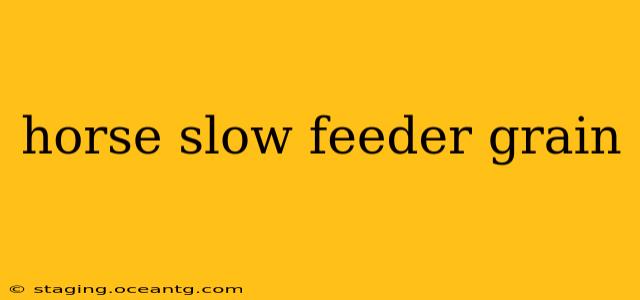Feeding horses is a crucial aspect of their overall health and well-being. A significant challenge for many horse owners is preventing overeating, which can lead to various health problems like colic, laminitis, and obesity. Slow feeders are designed to address this issue by mimicking natural grazing, encouraging horses to eat more slowly and deliberately. This comprehensive guide explores the benefits of slow feed hay nets and grain feeders for horses, addressing common questions and concerns.
What are the Benefits of Using a Slow Feeder for Horses?
Slow feeders significantly impact a horse's eating habits, promoting healthier digestion and reducing the risk of digestive disorders. By slowing down their eating process, horses experience a more natural grazing pattern, mimicking their natural foraging behavior in the wild. This leads to several key advantages:
- Reduced Risk of Colic: The slower eating pace helps prevent the overloading of the digestive system, a major contributor to colic.
- Improved Digestion: The gradual consumption allows for better nutrient absorption and reduces the chances of digestive upsets.
- Weight Management: Slow feeders can assist in weight management by promoting satiety and preventing overconsumption, particularly beneficial for horses prone to obesity.
- Reduced Boredom and Stress: The act of foraging provides mental stimulation, helping to alleviate boredom and reduce stress-related behaviors like cribbing.
- Dental Health: The act of chewing longer promotes better dental health.
What Types of Slow Feeders are Available for Horses?
Several types of slow feeders cater to different needs and preferences. They generally fall into two main categories: hay nets and grain feeders.
-
Hay Slow Feeders: These are designed to dispense hay at a slower rate. They come in various designs, from simple mesh nets to more complex designs with multiple compartments and openings. Some even incorporate features to prevent waste and encourage more thorough consumption.
-
Grain Slow Feeders: These are specifically designed for grain, helping horses eat their feed more slowly and preventing them from gulping it down. They often feature compartments, obstacles, or maze-like designs to extend feeding time.
The best type of slow feeder for your horse depends on factors like the horse's breed, age, health conditions, and feeding habits.
How Do I Choose the Right Slow Feeder for My Horse?
Choosing the right slow feeder involves considering several factors:
- Horse's Size and Breed: Larger breeds will likely require larger feeders.
- Feeding Habits: Observe your horse's eating patterns to determine the appropriate feeding rate.
- Type of Feed: Choose a feeder suitable for hay or grain, or one that can accommodate both.
- Durability: The feeder should be robust enough to withstand regular use and the horse's chewing habits.
- Ease of Cleaning: Opt for a design that is easy to clean and maintain.
Are Slow Feeders Suitable for All Horses?
While slow feeders offer numerous benefits, they may not be suitable for all horses. Horses with certain medical conditions or those requiring specific feeding plans might need individual adjustments or might not benefit from using a slow feeder. Always consult with your veterinarian before introducing any significant changes to your horse's feeding routine.
What are the potential downsides of using a slow feeder?
While slow feeders are generally beneficial, there are some potential downsides to consider:
- Initial Adjustment Period: Some horses may take time to adjust to a slow feeder.
- Potential for Choking: Always supervise your horse during the initial adjustment period and ensure the hay or grain is of an appropriate size to prevent choking.
- Cost: High-quality slow feeders can be more expensive than traditional feed buckets.
- Cleaning and Maintenance: Slow feeders require regular cleaning to maintain hygiene.
How do I introduce a slow feeder to my horse?
Introduce the slow feeder gradually to minimize stress and allow your horse to adapt to the new eating style. Start by using the slow feeder for short periods initially, gradually increasing the duration as your horse becomes accustomed to it. Always supervise your horse while it's using the slow feeder.
Conclusion
Slow feeders are a valuable tool for promoting healthier eating habits in horses, ultimately improving their overall well-being. By slowing down the eating process, these feeders help prevent overeating, improve digestion, and reduce the risk of digestive problems. However, it’s crucial to choose the right type of slow feeder for your horse's specific needs and to introduce it gradually. Always consult with your veterinarian to ensure the slow feeder is appropriate for your horse's health and dietary requirements.
